Final report for ONE15-238
Project Information
The goal of our project is to explore the possibility of improving genetic selection of milk proteins in dairy cattle through the examination of the variation in individual milk proteins such as casein, alpha lactalbumin and beta lactoglobulin. It is our hope that our study will reveal significant variation and yield an improved ability to make genetic progress by allowing breeders to select for individual milk proteins instead of crude protein. The ability to generate lines of cattle that excel in one protein fraction over another would result in a new level of efficiency on the industrial side of dairy as one of the major challenges in different areas of dairy processing is dealing with protein byproducts. The key components of our study consisted of obtaining three consecutive milk samples at two week intervals from a large herd of dairy cattle to reduce environmental influence on the variation in the protein fractions. The sampling took place at Sunnyside Farms in Scipio Center, NY. Due to the rotary style parlor in place at this location we were able to obtain samples from ~1200 cows over the course of our sampling period. In addition, we collected samples from 30 cows at calving and followed them throughout their lactations (~6 months) to examine how much the milk protein fractions change as a cow progresses through her lactation. Our results showed a significance in the amount of variation in casein and alpha-lactalbumin (P-value <.0001) but no significance in the variation in the amount of beta-lactoglobulin (P-value .5542).

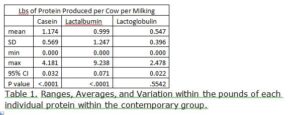
1. Obtain samples – Completed. Our sample collections were accomplished and a sufficient number of cows were sampled.
2. Verify chemical fractionation procedures and modify as necessary – Completed.
3. Perform chemical fractionation on all samples obtained – Completed.
4. Determine variation in milk proteins – Completed.
5. Share results with key dairy industry leaders to utilize data to make the dairy industry more efficient – Completed.
Cooperators
Research
10 mL post-milking samples will be obtained from 1,500 mid to late lactation cows on three separate occasions. Only cows with grossly normal milk will be sampled. The samples will be obtained in the same manner on each sample day. Sterile technique is unnecessary but gross contamination of the sample will be avoided. Milk yields from each cow on the sample day will be recorded. Samples will be transported chilled and stored frozen until all samples are collected (the last samples will be frozen then thawed to maintain testing conditions). The three samples from each cow will be thawed in a refrigerator for 12 hours before fractionation. After the twelve hours, the samples will be pooled into one milk vial and then split into two 15 mL centrifuge tubes. To remove the fat, the milk samples will be centrifuged at 12,000 rpm for 30 minutes. The fat layer will be removed and the remaining skim milk will be heated to 40 °C, upon reaching this temperature, 10% acetic acid (1 mL 100% acetic acid + 9 mL distilled water) will be added drop wise to a 10 mL sample until a pH of less than 4.6 is achieved and no additional casein is precipitated. The samples will then be centrifuged at 5,000 xg for 10 minutes and the supernatant poured off but saved. The pelleted precipitate will be allowed to dry for 48 hours before being weighed. This weight will represent the casein concentration of the milk. To isolate alpha lactalbumin, 0.25 mL of whey will be diluted with 0.75 mL of distilled water in a tube and acidifed with 0.04 mL 10 M of HCL. The acidified mixture will be heated to 100 °C for two minutes upon which it will be cooled by quenching to between 40 °C and room temperature. Then 4.2 mL of ethanol will be added. This mixture should be centrifuged at 5,000 xg for 10 minutes and the pelleted material discarded. The pH of the supernatant will be increased to 4.5 by adding 1 M NaOH to precipitate the alpha-lactalbumin. The supernatant will be poured off and the pelleted precipitate will be allowed to dry for 48 hours before being weighed. This weight will represent the alpha-lactalbumin fraction of the milk (Heine et al., 1992). Of the remaining whey, 10 mL will be used and the pH will be increased to 6.2 with 1 M NaOH and 3 mg/mL of chitosan added. The mixture will be stirred vigorously for one minute and allowed to stand for 30 minutes before being centrifuged at 5,000g for 10 minutes. The supernatant will be poured off and the pelleted precipitate will be allowed to dry for 48 hours before being weighed. This weight will represent the beta-lactoglobulin fraction of the milk (Casal et al., 2006). Data analysis will be performed to determine the amount of variation between cows. The same procedure will be carried out for the 15 fresh cows, except instead of just three milk samples, their milk will be sampled once a month for six months.
Heine, W. E., P. D. Klein, and P. J. Reeds. "The Importance of Alpha-lactalbumin in Human Nutrition." The Journal of Nutrition 121.3 (1991): 227-83. Web. 4 Dec. 2016.
Casal, E. Montilla, A. Moreno, F.J. Olano, A. Corzo, N. "Use of Chitosan for Selective Removal of B-Lactoglobulin from Whey." J. Dairy Sci. 89 (2006):1384-1389. Web. 4 Dec. 2016.
There is a wide range each of the individual milk proteins we analyzed for present within cows in a large contemporary group (See figures 1-3). This indicates that there is a large genetic variance in each protein fraction within the U.S. Holstein population despite there being very little genetic variance in total milk protein, whether analyzed from pounds or percentage standpoint. Our data confirms that cows that are high in one milk protein are frequently relatively lower in the other two fractions we analyzed.
There is the least amount of variation in the beta lactoglobulin, which wasn’t statistically significant from the previously published variation in milk protein of 0.15. The other two milk protein fractions were highly significant with p<.0001 when compared to the reported variation in total milk protein, indicating significance to being able to separate and quantify the individual fractions.
There was no significant impact found for days in milk versus level of production of any of the protein fractions. There was a large amount of noise in this small sample size of fresh cows, but it is clear that there are many environmental and management factors, especially nutrition and herd health, which impact the protein levels much more so than stage of lactation.
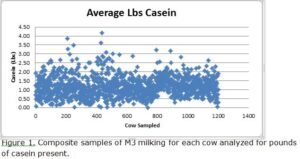
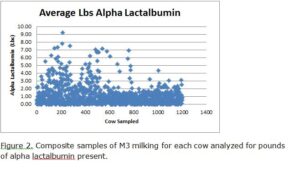
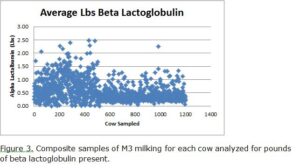
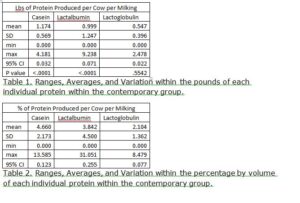
Figure 1. Composite samples of M3 milking for each cow analyzed for pounds of casein present.
Figure 2. Composite samples of M3 milking for each cow analyzed for pounds of alpha lactalbumin present.
Figure 3. Composite samples of M3 milking for each cow analyzed for pounds of beta lactoglobulin present.
|
Lbs of Protein Produced per Cow per Milking |
|||
|
Casein |
Lactalbumin |
Lactoglobulin |
|
|
mean |
1.174 |
0.999 |
0.547 |
|
SD |
0.569 |
1.247 |
0.396 |
|
min |
0.000 |
0.000 |
0.000 |
|
max |
4.181 |
9.238 |
2.478 |
|
95% CI |
0.032 |
0.071 |
0.022 |
|
P value |
<.0001 |
<.0001 |
.5542 |
Table 1. Ranges, Averages, and Variation within the pounds of each individual protein within the contemporary group.
|
% of Protein Produced per Cow per Milking |
|||
|
Casein |
Lactalbumin |
Lactoglobulin |
|
|
mean |
4.660 |
3.842 |
2.104 |
|
SD |
2.173 |
4.500 |
1.362 |
|
min |
0.000 |
0.000 |
0.000 |
|
max |
13.585 |
31.051 |
8.479 |
|
95% CI |
0.123 |
0.255 |
0.077 |
Table 2. Ranges, Averages, and Variation within the percentage by volume of each individual protein within the contemporary group.
The results of our study have raised a variety questions and possibilities for future research. At this time, a follow up study comparing protein fractions from farm to farm is beginning as well as work on developing a better and easier way to fraction-ate the proteins and provide farmers with performance as well as genetic data to being the selection criteria process. If a successful breeding program is developed and significant genetic improvement is made, breeding for individual milk proteins will become the new gold standard for the dairy industry to allow genetic progress for milk protein components to become a reality whether or not a market develops for individualized protein fractions.
There is a significant amount of additional work that needs to be done to follow up on this study now that we have proven that there is significant variation in the individual milk proteins. First, we are planning a study to determine the variance and consistency in said variation from farm to farm based on milk tanker analysis performed in conjunction with a local cooperative. Additional studies will need to be conducted to determine the loci and SNPs that correspond to each protein fraction. Furthermore, additional work needs to be done to develop a less intensive, more scale-able process for individual protein purification before it can become a reality in the marketplace. There are lots of studies currently being conducted on various proteins within the human nutrition field and these studies will be critical to providing more information about the benefits and uses of various milk protein components which will complement the cattle studies.
Education & Outreach Activities and Participation Summary
Participation Summary:
A journal article about our project is being written and will be submitted to the Journal of Dairy Science by the fall of 2017. We also hosted a producer outreach night at the Cayuga County CCE in early April 2017 where we met with local producers, milk cooperative representatives, and industry experts to discuss our results and brainstorm opportunities to utilize this data. It was agreed that the next logical step would be to analyze differences between farms and also refine the fractionation protocols to make the procedure less time consuming and easier to scale.
Learning Outcomes
All of the farmers we spoke with regarding our results found the data to be very interesting and promising for further development. The farmer/owner board members of Cayuga Milk Marketing asked us to continue our research with a follow up study looking at farm to farm differences in protein content of tank samples collected at the time of milk pick up. They unanimously agreed that improving milk protein selection criteria would improve the sustainability and profitability of the milk industry, especially as fluid milk consumption declines and milk protein sales increase. A recent study on medicinal uses of individual milk proteins, specifically the use of alpha-lactalbumin underscores the value and importance of milk proteins and it is our hope that someday farmers can utilize the data our study discovered. First we will need to establish heritabilities for the individual proteins and find practical applications for the individual proteins to justify their purification beyond the current methods.
Project Outcomes
The results of our study have raised a variety questions and possibilities for future research. At this time, a follow up study comparing protein fractions from farm to farm is beginning in cooperation with Cayuga Milk Marketing coop, as well as work on developing a better and easier way to fractionate the proteins and provide farmers with performance as well as genetic data to being the selection criteria process. If a successful breeding program is developed and significant genetic improvement is made, breeding for individual milk proteins will become the new gold standard for the dairy industry to allow genetic progress for milk protein components to become a reality whether or not a market develops for individualized protein fractions.